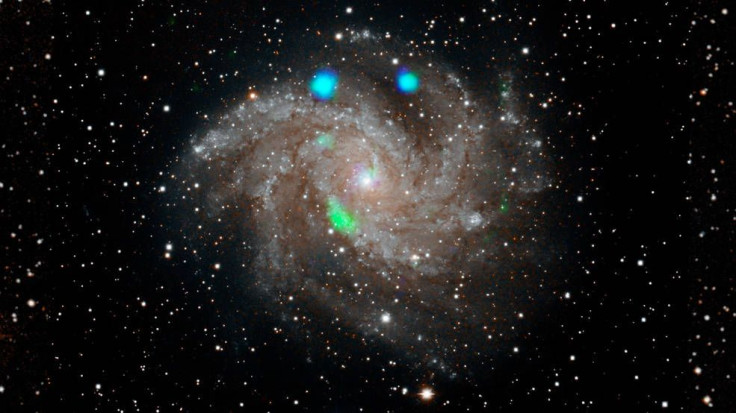NASA Photo Of Rare Fireworks Galaxy Shows Black Hole Consuming A Star

NASA was able to capture a stunning photo of the Fireworks galaxy known as NGC 6946. According to the scientists, the incredible light show coming from the galaxy may have been produced by a black hole devouring a star.
The image of the galaxy was captured using the Nuclear Spectroscopic Telescope Array (NuSTAR), an X-ray space telescope launched by NASA to specifically observe supermassive black holes.
In the latest photo captured by NuSTAR, a stunning spiral galaxy with orbs of bright lights can be seen. According to NASA, the orb at the upper right of the photo, which has a blue-green color, was actually produced by a supernova. The agency noted that the star responsible for this phenomenon was bigger than the Sun.
As for the green orb at the bottom of the galaxy, scientists noted that it only appeared 10 days after NuSTAR’s first observation of NGC 6946.
“Ten days is a really short amount of time for such a bright object to appear,” Janna Earnshaw, the lead author of the study about NuSTAR’s observations said in a statement. “Usually with NuSTAR, we observe more gradual changes over time, and we don’t often observe a source multiple times in quick succession.”
“In this instance, we were fortunate to catch a source changing extremely quickly, which is very exciting,” she added.
Pops of green & blue scintillate from this image of the (appropriately named) Fireworks galaxy. Observed by our NuSTAR space observatory, these x-ray flashes were generated by some of the most energetic processes in the universe — including supernovas. https://t.co/V8Ybdydz7Y pic.twitter.com/96j8T7SoOg
— NASA (@NASA) September 8, 2019
The sudden appearance of the green flash of light led scientists to theorize that it may have actually been caused by a black hole. They noted that the light may have been produced as the black hole consumed a star or other cosmic object.
According to their study, if an object gets pulled closer into a black hole, it will be destroyed by the strong gravitational forces. The debris from the cosmic object’s destruction will closely orbit the black hole. As the various materials go around the black hole, the acceleration can cause them to heat up to millions of degrees and radiate X-rays.
According to Earnshaw, NuSTAR’s observation and their study can provide a deeper understanding of how black holes can become powerful sources of X-rays.
“This result is a step towards understanding some of the rarer and more extreme cases in which matter accretes into black holes or neutron stars,” he said.
The study conducted by Earnshaw and her team was published in the Astrophysical Journal.
© Copyright IBTimes 2024. All rights reserved.





















